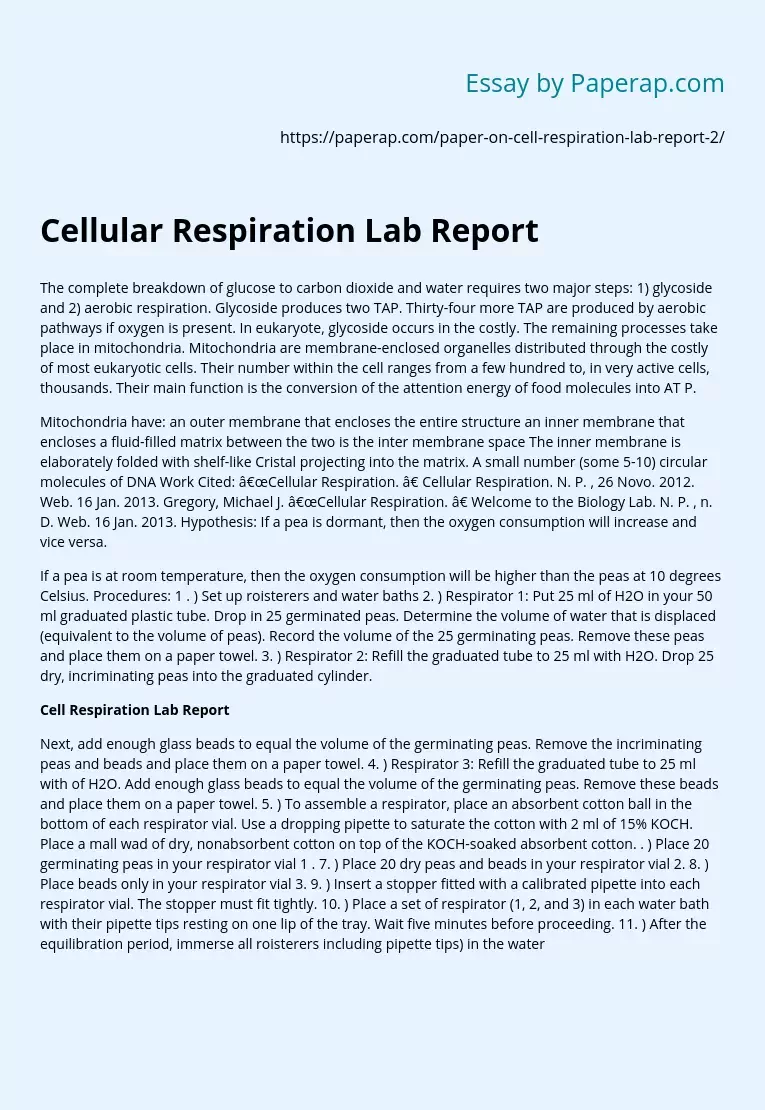Cell Respiration
The complete breakdown of glucose to carbon dioxide and water requires two major steps: 1) glycoside and 2) aerobic respiration. Glycoside produces two TAP. Thirty-four more TAP are produced by aerobic pathways if oxygen is present. In eukaryote, glycoside occurs in the costly. The remaining processes take place in mitochondria. Mitochondria are membrane-enclosed organelles distributed through the costly of most eukaryotic cells. Their number within the cell ranges from a few hundred to, in very active cells, thousands. Their main function is the conversion of the attention energy of food molecules into AT P.
Mitochondria have: an outer membrane that encloses the entire structure an inner membrane that encloses a fluid-filled matrix between the two is the inter membrane space The inner membrane is elaborately folded with shelf-like Cristal projecting into the matrix. A small number (some 5-10) circular molecules of DNA Work Cited: “Cellular Respiration. ” Cellular Respiration. N. P. , 26 Novo. 2012. Web. 16 Jan. 2013. Gregory, Michael J. “Cellular Respiration. ” Welcome to the Biology Lab.
N. P. , n. D. Web. 16 Jan. 2013. Hypothesis: If a pea is dormant, then the oxygen consumption will increase and vice versa.
If a pea is at room temperature, then the oxygen consumption will be higher than the peas at 10 degrees Celsius. Procedures: 1 . ) Set up roisterers and water baths 2. ) Respirator 1: Put 25 ml of H2O in your 50 ml graduated plastic tube. Drop in 25 germinated peas. Determine the volume of water that is displaced (equivalent to the volume of peas). Record the volume of the 25 germinating peas. Remove these peas and place them on a paper towel.
3. ) Respirator 2: Refill the graduated tube to 25 ml with H2O. Drop 25 dry, incriminating peas into the graduated cylinder.
Cell Respiration Lab Report
Next, add enough glass beads to equal the volume of the germinating peas. Remove the incriminating peas and beads and place them on a paper towel. 4. ) Respirator 3: Refill the graduated tube to 25 ml with of H2O. Add enough glass beads to equal the volume of the germinating peas. Remove these beads and place them on a paper towel. 5. ) To assemble a respirator, place an absorbent cotton ball in the bottom of each respirator vial. Use a dropping pipette to saturate the cotton with 2 ml of 15% KOCH. Place a mall wad of dry, nonabsorbent cotton on top of the KOCH-soaked absorbent cotton. . ) Place 20 germinating peas in your respirator vial 1 . 7. ) Place 20 dry peas and beads in your respirator vial 2. 8. ) Place beads only in your respirator vial 3. 9. ) Insert a stopper fitted with a calibrated pipette into each respirator vial. The stopper must fit tightly. 10. ) Place a set of respirator (1, 2, and 3) in each water bath with their pipette tips resting on one lip of the tray. Wait five minutes before proceeding. 11. ) After the equilibration period, immerse all roisterers including pipette tips) in the water bath.
Position the roisterers so that you can read the scales on the pipettes. The paper should be under the pipettes to make reading them easier. Do not put anything else into the water baths or take anything out until all readings have been completed. 12. ) Allow the roisterers to equilibrate for another five minutes. Then, observe the initial volume reading on the scale to the nearest 0. 01 ml. Record the data in Table 1 for Time O. Also, observe and record the temperature. Repeat your observations and record them every five minutes for 20 minutes.
Cell Respiration. (2019, Dec 05). Retrieved from https://paperap.com/paper-on-cell-respiration-lab-report-2/

